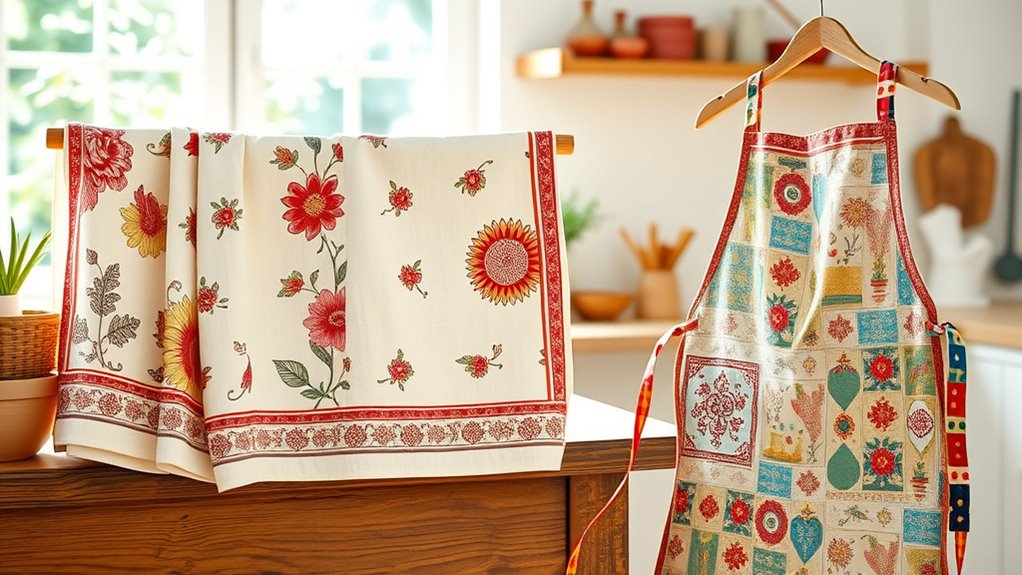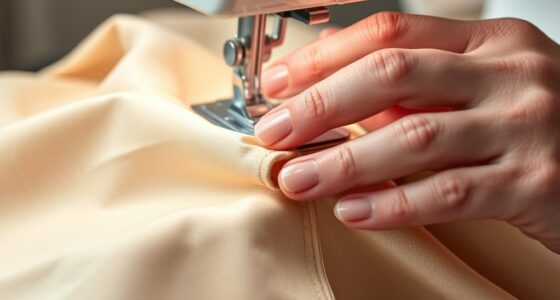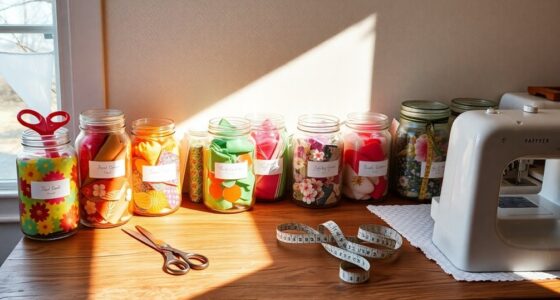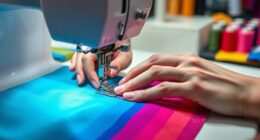To quickly turn tea towels into retro aprons, start by choosing charming vintage fabrics and using the existing hem as the apron’s bottom edge. Measure and cut the fabric for the desired style, then sew or glue the pieces together, adding straps from contrast fabric or bias tape. Embellish with buttons or embroidery for a personal touch. With simple steps and smart reuse, you’ll craft a stylish apron in no time—discover more tips for perfect results ahead.
Key Takeaways
- Use the existing hem of the tea towel as the apron’s bottom edge to save time and preserve a vintage look.
- Measure and cut fabric to desired apron shape, incorporating the tea towel’s pattern and texture for a retro style.
- Sew or glue straps and ties from bias tape or fabric strips, ensuring secure attachment and vintage-inspired contrast.
- Add decorative details like pockets, embroidery, or vintage buttons for personalized retro charm.
- Try on, adjust straps, and secure ties for a quick, stylish, one-of-a-kind apron ready for use or gifting.

If you’re looking for a creative way to give new life to old tea towels, repurposing them into aprons is a practical and fun solution. Not only does this approach save money, but it also transforms vintage fabric ideas into stylish, functional garments. To get started, you’ll want to gather your tea towels, scissors, sewing machine, and basic sewing supplies. When it comes to upcycling tips, choosing the right fabric is key. Look for tea towels with charming patterns, bold colors, or nostalgic prints that can serve as the focal point of your apron. These vintage fabrics often have a unique charm that adds character to your handmade piece.
Transform old tea towels into charming, functional aprons—an eco-friendly, stylish way to upcycle vintage fabrics.
Next, measure yourself or the intended wearer to determine the apron size and shape. Keep it simple with a classic bib style, or add a touch of flair by incorporating pockets or decorative trims. When cutting your fabric, be precise to ensure clean lines and a polished look. Use the existing hem of the tea towel as the bottom edge of your apron if possible, saving time and maintaining the vintage aesthetic. For the straps, cut strips from the remaining fabric or repurpose bias tape if you have it on hand. Upcycling tips suggest using contrasting fabrics for the neck and waist ties to create visual interest, or match them for a cohesive look. Incorporating raw fabric ideas can add a textured, rustic feel to your apron design.
Sew the pieces together with a straight stitch, making sure to reinforce stress points like the ties and neck loop. If you’re new to sewing, consider using fabric glue or fusible webbing for a no-sew option, especially for decorative elements. Embellishments like embroidery, appliqué, or vintage buttons can give your apron a truly personalized touch. Remember, upcycling isn’t just about recycling fabric; it’s about creatively reimagining what you have, so don’t be afraid to experiment with different techniques or mix vintage fabric ideas with modern elements.
Once assembled, give your apron a good press to set the seams, and try it on for fit. Adjust the straps if needed, and make sure the ties are comfortable and secure. The beauty of repurposing tea towels into aprons lies in the fact that each piece becomes one-of-a-kind, reflecting your style and creativity. With a little effort and some basic sewing skills, you’ll turn those old tea towels into retro aprons that are perfect for cooking, crafting, or gifting. Not only do you enjoy a practical item, but you also keep vintage fabric ideas alive, giving them a new purpose and preserving their charm for years to come. Additionally, considering food safety practices when handling fabric related to kitchen use can add an extra layer of safety to your project.
Frequently Asked Questions
What Are the Best Fabrics for Repurposing as Aprons?
When choosing fabrics for aprons, you want durable materials that can withstand frequent use and washing. Look for fabrics like canvas, denim, or heavy cotton, which offer great fabric durability. Additionally, opt for colorfast materials to prevent fading over time. These fabrics not only last longer but also keep their vibrant appearance, making your apron both stylish and practical. Always prioritize sturdy, colorfast textiles for the best results.
Can I Add Pockets to My Repurposed Apron?
Yes, you can definitely add pockets to your repurposed apron. First, decide on pocket placement—either on the front for easy access or on the sides for style. Use simple sewing techniques like straight stitches to attach the pockets securely. Make sure to reinforce the edges for durability, especially if you’ll store heavier items. Customizing pocket size and placement makes your apron both functional and uniquely yours.
How Do I Prevent Fraying During Sewing?
To prevent fraying during sewing, you should focus on edge finishing and seam sealing. First, finish the edges with a zigzag stitch or use pinking shears to cut a zigzag pattern, which helps reduce fraying. Then, apply seam sealing or use a serger to secure raw edges. These techniques keep your fabric intact and give your apron a polished look, ensuring longevity and durability.
What Tools Are Essential for Making Retro Aprons?
To make retro aprons, you need a sewing machine and sharp scissors. The sewing machine helps you stitch fabric quickly and neatly, while scissors are essential for cutting your tea towels and fabric pieces accurately. You might also want pins or clips to hold pieces in place. Having these tools on hand makes the process faster and easier, ensuring your apron turns out stylish and durable.
Are There Eco-Friendly Ways to Dispose of Leftover Fabric?
When considering eco-friendly disposal of leftover fabric, you can explore fabric recycling options or donate unused pieces to local charities or community projects. You might also repurpose scraps into patchwork, quilting, or craft projects, reducing waste. Avoid tossing fabric in regular trash to minimize landfill impact. These eco-friendly disposal methods help you reduce waste and support sustainability while making the most of your fabric leftovers.
Conclusion
Now that you know how easy it is to turn tea towels into retro aprons, you’ll find yourself customizing them for every occasion. It’s like giving your kitchen a splash of vintage charm, all while recycling and saving money. With just a few simple steps, you can create a stylish, functional apron that reflects your personality. So go ahead—get creative and transform those ordinary tea towels into timeless pieces, adding a touch of flair to your cooking adventures.









